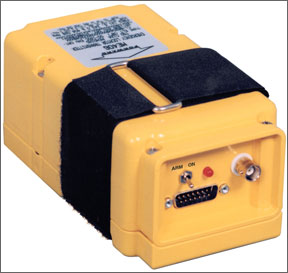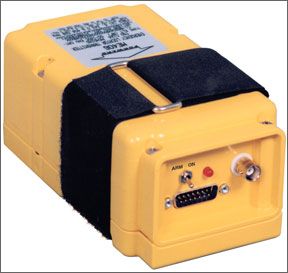New motorcyclists often ask how much they should spend for a helmet. The flippant answer is, “How much is your head worth?” While not very satisfying, its true to a great extent: The helmets offering the best protection and comfort are typically the most expensive. This is largely true for ELTs; the solution most likely to enable a timely rescue under adverse conditions is probably going to cost a lot. As pilots, we constantly balance cost, risk, safety, practicality 288 and utility. There are always trade-offs to weigh in making just about any decision. Now, we can add ELTs to the list of items whose cost we must balance against the risks well encounter and the degree of safety we want to achieve. A Little History The FAA first mandated ELTs as a result of Congressional action in the early 1970s. The first ELTs were covered by TSO C-91 and simply transmitted a warbling tone on the international emergency frequencies of 121.5 and 243.0 MHz, with the expectation that they would be detected by ATC or by other aircraft. Unfortunately, those early ELTs only worked in actual crashes less than 25 percent of the time. (See the sidebar on page 6) To improve the activation rate, the FAA revised its standards in 1985 and issued TSO C-91A, bringing the rate up to 73 percent. Its no secret among aircraft owners that real-world behavior of ELTs is well short of the promise. In addition to unreliable activation, a working ELT would frequently go undetected, due to remoteness of its location, damage to the device or obstruction of its antenna. The idea of ATC and overflying aircraft hearing the 121.5 MHz signal was simply not working out. Thus, an international agreement reached in 1982 initiated satellite monitoring of ELTs. This offered two advantages: It was far more likely for an orbiting satellite to be able to detect an activated ELT and the orbital motion of the satellite allowed it to get an approximate fix for search and rescue operations. Although satellite monitoring was successful, its potential was thwarted by very high false alarm rates, as high as 94 percent according to some sources. Since the satellites could ideally process only 10 signals at a time, they were frequently rendered unusable by false signals. For these and other reasons, satellite monitoring of 121.5 MHz ELTs was terminated early last year. For the many thousands of these remaining beacons, were back to only ATC and aircraft monitoring. At present, the FAA does not plan to legally obsolete the beacons, even if technology has left them far behind. The next step, begun in the 1990s, was a completely revised standard, TSO C-126, for a new generation of all-digital ELTs operating on 406.025 MHz. These devices transmit digital data to uniquely identify you and/or your aircraft. They also can optionally send location data from an internal or external GPS. These ELTs have an 82-percent activation rate, according to the AOPA. Given the vagaries of what can happen in a crash, that may be about as good as can be expected. Finally, while the 121.5 MHz units continuously transmit a relatively low-power signal, the 406 MHz units “squirt” their data at much higher power for a few milliseconds every five minutes, further improving the likelihood of detection. The 406 MHz ELTs are intended to be detected solely by satellite. Thus, to help search and rescue personnel find the precise location, these ELTs transmit on 121.5/243.0 MHz as well. Choices So, what are your choices? If you have a 121.5 MHz ELT, you may continue using it. Even Transport Canadas plans to ban these older devices has been put on hold. But with the loss of satellite monitoring and all the other problems with the design, their efficacy is quite limited and they may quite literally be little more than a place to age expensive batteries. As discussed above, 406 MHz ELTs transmit your identification and optionally your GPS location. This comes at a cost-over $1000 up to a few thousand after installation. If you want the GPS interface option you can typically add another $1000 for the hardware, plus more time for the installation. There are also handheld portable models known as personal locator beacons, PLBs. The primary difference is that PLBs arent mounted to the aircraft and must be activated manually. A modern PLB can be found for a couple hundred dollars and up, with or without a built-in GPS. Given the low price difference, wed only suggest a PLB with GPS. In addition to the three generations of ELTs and PLBs, theres a new kid on the block: companies providing a device that is satellite monitored through a private service. One such company making a splash is Spot (www.findmespot.com). These are personal beacons from which you can send a few different canned status messages, such as an emergency call for help or just an “alls well” update to recipients you determine when setting up the service. In an emergency, the monitoring service will contact emergency services local to the point from which the message was sent. Entry price is low-as little as $100 for a basic model-but there is the ongoing fee for the service that begins at about $100 per year and goes up with additional features. There is a variation on this idea from other companies that provides continuous real-time tracking and can provide alerts in the event the tracked device unexpectedly stops, but this is a more expensive option. Finally, we should note that ELTs-whether 121.5 or 406 MHz-are still mandated. You can supplement your choice of ELT with a PLB or a Spot-like device, but most of us still must have a working ELT permanently mounted in our aircraft. Get Rescued The objective of any emergency beacon is to aid in prompt detection and location (and ultimately rescue) in the event of a crash. Detection and location are entirely different and must be examined separately. If you crash, only an ELT will (hopefully) self-activate. The 406 MHz ELTs have the highest likelihood of proper activation, while the oldest, first-generation 121.5 MHz ELTs are so unlikely to properly activate, we think they should be junked. However, the ultimate goal is detection, not just activation. With only ground-based fixed stations and aircraft monitoring 121.5 MHz and with the vagaries of the directionality of that frequency, you are only moderately likely to have someone hear and properly report receiving your beacon. Satellite-monitored 406 MHz ELTs and PLBs-as well as privately monitored PLBs-give you the highest chance of being promptly detected. Once your beacon is detected, you must be located. Again, the 121.5 MHz ELTs are at a significant disadvantage. They only transmit a signal and the source of that signal must be located via direction-finding techniques. Thats fine in flat, open terrain, but if you are in a rugged mountainous area, its possible for the signal to become so confused by bouncing around the terrain that even skilled searchers might not find you in time. Satellite monitoring of the 406 MHz beacons and the privately monitored PLBs can provide an initial location that is said to be accurate within about three kilometers, even without GPS. Modern PLBs (including the private services) and 406 MHz ELTs can optionally transmit your precise GPS coordinates, but there is a difference. A 406 MHz ELT equipped with an internal GPS or connected to an external receiver is constantly monitoring your position and will transmit the coordinates taken immediately before the crash. Usually this will be your location but, even in the worst possible case, would only be a short distance away. Manually activated devices must get a GPS fix when they are turned on and activated-if they cant see the sky from the crash location, no fix. A successful GPS fix is said to provide location accuracy within a mere 22 meters. Whats Your Risk? Probably the first step in deciding which type of emergency beacon is right for you is to assess your risk and risk tolerance. Do you fly in the backcountry over inhospitable terrain? Do you have a high risk of an accident that could present a significant emergency simply because of the remoteness and unpredictability of your location? On the other hand, do you fly a pressurized twin in the flight levels between major airports, always talking with ATC on an IFR flight plan, who will notice in minutes if you go missing and have you on radar for an initial fix? Most of us, of course, typically operate between these two extremes; you should assess your individual situation before making a decision. Do you often fly in areas where radio frequencies can become scattered by the terrain? Do others know when youre flying and do they know your route to a high degree of certainty? When you fly, are you always within radar coverage and talking with ATC? The answers to these kinds of questions can help you determine your individual risk. Another factor that should be considered is how likely you are to be able to manually activate a PLB after a crash. If youre flying a high-performance speedster, a crash would seem more likely to disable you than if youre out in your J-3. Your Choice While most of this is specific to your circumstances of risk and your ability to spend money for the right device, we can make some recommendations. To start, if youve got one of the first generation 121.5 MHz ELTs (You can determine these by the TSO C-91-not C-91A-shown on the data plate.), junk it. The low rate of successful activation is just too high a risk. Regardless of your risk, if you can cost-justify a 406 MHz beacon, preferably with GPS data, this is what you should install. If you operate in the bush, often using unimproved landing sites, or even if you use regular airports but frequently like to “carve though the canyons,” we strongly recommend a 406 MHz ELT with GPS interface. You simply have too high a risk to consider anything less. On the other hand, perhaps you and your J-3 only fly in great weather and seldom range more than a few miles from the home drome over easy terrain. If someone always knows where youll be and you really cant justify the cost of a new ELT, your risk may be low enough that you could get by with a second-generation (TSO C-91A) 121.5 MHz ELT. Of course, its harder to make specific recommendations if you only occasionally fly over inhospitable terrain or take ad hoc flights where nobody knows your location. If you can justify the cost, we again must recommend a 406 MHz ELT. If you ever find yourself disabled, upside-down in a ravine somewhere, youll certainly wish you had the best emergency beacon you could get. In any case, if you cant justify the cost of the 406MHz ELT-or even if you can-consider adding a modern PLB to your flight bag, or better yet to your pocket. If you do crash and are disabled, hopefully your ELT will at least get someone looking for you. If you can activate your PLB under a clear sky, youll know it will notify the authorities and provide a reasonably accurate initial fix (or better, if it has GPS). If youre an outdoor enthusiast who frequently seeks out remote locations on the ground, a privately monitored device like Spot may be the best choice since it has the significant advantage of offering the peace of mind of keeping others updated on your progress. This discussion, however, can only provide general guidelines. You must assess your own exposure, risk tolerance and budget. In the final analysis, perhaps the old adage about motorcycle helmets is best.




